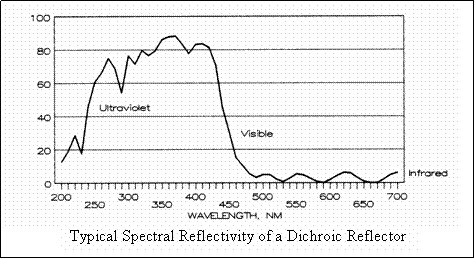Guide to UV Measurement
Dichroic Reflectors
There have been elaborate and costly methods applied to reducing IR from UV lamps, but by far the simplest and most direct is the use of a dichroic reflector. Dichroic reflectors are designed to be non-reflective to IR emitted from the lamp. Whether the transmission-type or absorbing-type, they reduce the focused IR, and consequently the temperature to which the surface rises.
A reflector having good reflectance to UV and poor reflectance to IR (intentionally), can reduce the IR irradiance at the surface while providing focused UV. Reflectors designed with this different reflectivity to different wavelength ranges are often referred to as dichroic . A good dichroic reflector will reflect nearly all of the UV.

The dichroic reflector can enhance reflectance in specific wavelength ranges, while suppressing others. The result is a change in the spectral distribution of UV delivered to the work surface. Understanding and measuring the spectral irradiance is even more critical when using dichroics, as the spectral distribution is significantly affected by the reflector.
This is a reflectance curve for a dichroic reflector. There is little reflection of visible or IR radiation. (Transmitting types will look nearly transparent, and absorbing types will appear to be a deep purple to the eye).
Dichroic reflectors can effectively reduce the IR from UV lamps and reduce surface temperature.